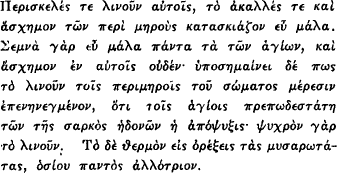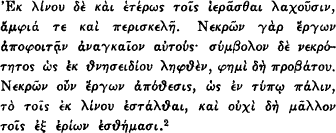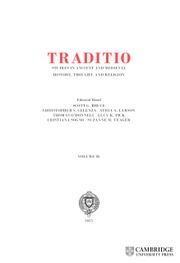Article contents
Cyril of Alexandria on “Wool and Linen”
Published online by Cambridge University Press: 17 July 2017
Extract
Treating of the passage in Exodus which prescribes, among the holy vestments for Aaron and his sons, “linen breeches, to cover the flesh of their nakedness from the reins to the thighs,” Cyril of Alexandria remarks:


Their breeches are of linen, an excellent covering for the ugliness and unseemliness about the thighs. For all things connected with holy men are most honorable, and there is nothing unseemly in them. Now the linen placed upon the parts of the body about the thighs intimates that the cooling of the pleasures of the flesh is most becoming holy men: for linen is cool. But the heat that rouses the foulest desires is foreign to every holy man.
- Type
- Miscellany
- Information
- Copyright
- Copyright © 1944 by Cosmopolitan Science & Art Service Co., Inc.
References
1 Exodus , 28, 42 (Douay).Google Scholar
2 Cyril of Alexandria, De adoratione et cultu in spiritu et veritate , 11, 390 (PG 68, 749).Google Scholar
3 Quasten, J., “A Pythagorean Idea in Jerome,” American Journal of Philology , 63 (1942), 207–215.Google Scholar
4 Ep. 64, 19 (CSEL 54, 610 Hilberg).Google Scholar
5 Quasten, J., l.c. 212.Google Scholar
6 Plutarch, , De Iside et Osiride , 3–4 (Loeb Classical Library, 5, 13-14).Google Scholar
7 Quasten, J., l.c. 212.Google Scholar
8 Spitzer, L., “Additional Note on ‘Wool and Linen’ in Jerome,” American Journal of Philology , 64 (1943), 98–99, adduces an interesting parallel from Augustine: wool is the carnal, linen the spiritual, though mixed with another contrast, i.e. exterior vs. interior.Google Scholar
9 Exodus , 3, 5 (Douay).Google Scholar
10 Cyril of Alexandria, op. cit. 14, 511 (PG 68, 937).Google Scholar
11 Cf. Quasten, J., “Theodore of Mopsuestia on the Exorcism of the Cilicium,” Harvard Theological Review , 35 (1942), 209–219.CrossRefGoogle Scholar
- 23
- Cited by


